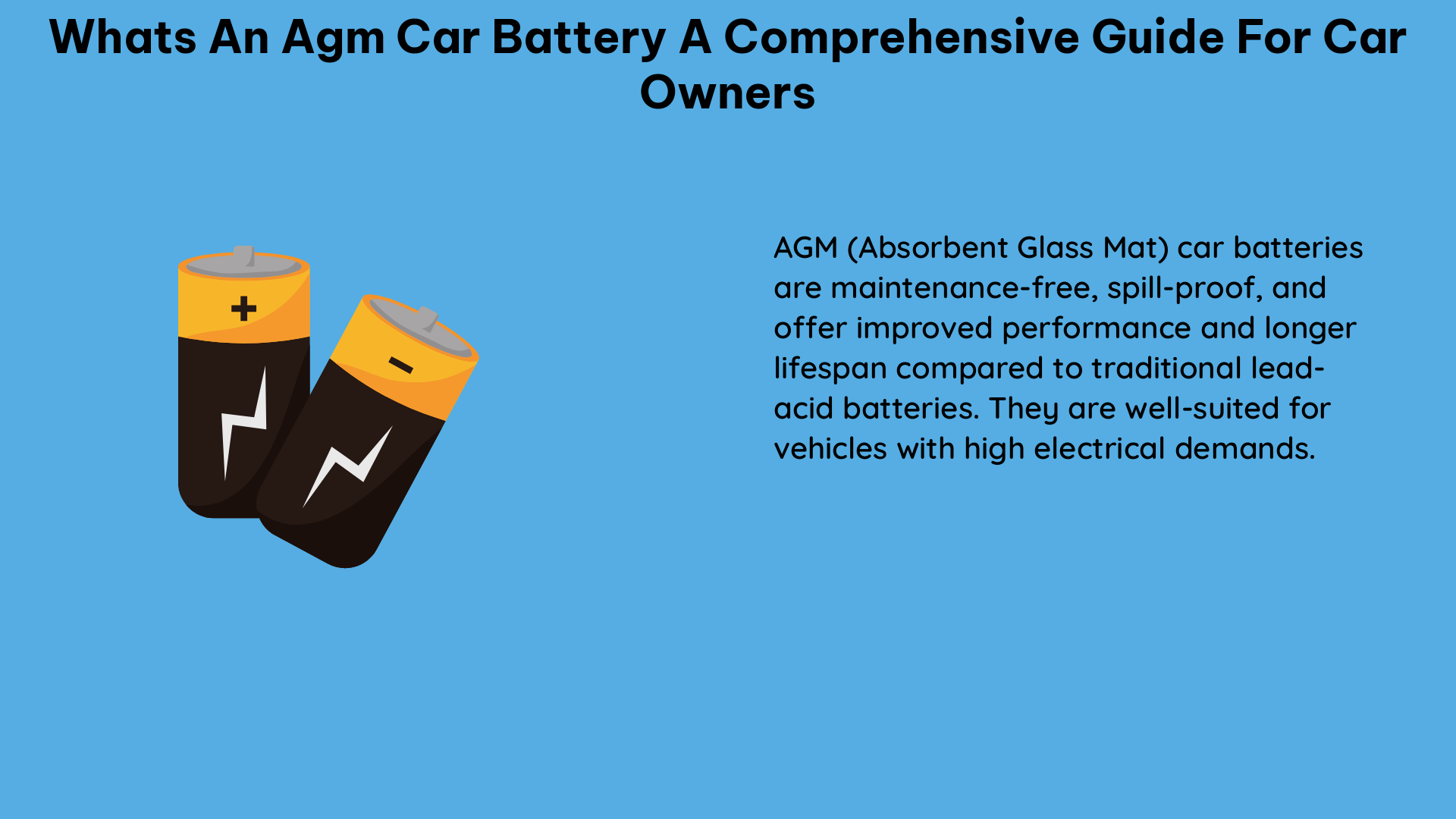An AGM (Absorbent Glass Mat) car battery is a type of lead-acid battery that utilizes a fiberglass mat to absorb and retain the electrolyte, making it spill-proof and maintenance-free. This design allows AGM batteries to be installed in various positions without the risk of leakage, and they also have a unique recombination process that minimizes the need for topping up the electrolyte.
Advantages of AGM Batteries
Deep Cycling Capabilities
AGM batteries excel in deep cycle applications, meaning they can be repeatedly discharged and recharged without significant degradation. This makes them ideal for vehicles with high power demands, such as those equipped with extensive electrical systems or used for off-road adventures.
Quick Charging and Discharging
AGM batteries have lower internal resistance compared to flooded lead-acid batteries, resulting in quicker charging and discharging. This is particularly beneficial for high-demand applications where rapid power delivery is required, such as in racing or emergency vehicles.
Vibration Resistance
AGM batteries are highly resistant to vibration and shock, making them a suitable choice for vehicles that experience constant motion, such as those used for off-roading or heavy-duty applications. This increased durability helps prevent premature failure and ensures reliable performance.
Low Maintenance
AGM batteries are maintenance-free, as they do not require regular electrolyte top-ups or watering. This convenience, combined with their spill-proof design, makes them an attractive option for car owners who want to minimize the hassle of battery maintenance.
Spill-proof and Maintenance-free
The absorbent glass mat design of AGM batteries eliminates the risk of electrolyte leakage, making them suitable for installation in various orientations without the need for upright positioning. This spill-proof feature, along with the reduced maintenance requirements, makes AGM batteries a popular choice for many vehicle applications.
Considerations Before Switching to AGM Batteries

Compatibility with Your Vehicle or System
Before switching to AGM batteries, it is crucial to ensure that your vehicle or system is compatible with them. Check your owner’s manual or consult a professional to verify that your charging system can properly accommodate AGM batteries to maximize their lifespan and performance.
Proper Charging System Capabilities
Not all vehicles can properly charge an AGM battery, as they require a specific charging profile to prevent overcharging or undercharging. Ensure that your vehicle’s charging system is compatible with AGM batteries to avoid premature failure or reduced battery life.
Cost Compared to Traditional Lead-Acid Batteries
AGM batteries are generally more expensive than traditional lead-acid batteries, so the cost difference should be considered when making the switch. However, the long-term benefits of AGM batteries, such as their deep cycling capabilities and reduced maintenance requirements, may offset the initial higher cost.
Maintenance and Care of AGM Batteries
Regular Charging
AGM batteries require regular charging to avoid leaving them in a discharged state for extended periods. Neglecting to charge an AGM battery can lead to sulfation, which can reduce the battery’s capacity and lifespan.
Proper Charging with an AGM-compatible Charger
When charging an AGM battery, it is essential to use a charger specifically designed for AGM batteries. These chargers have a charging profile tailored to the unique characteristics of AGM batteries, ensuring proper charging and preventing overcharging or undercharging.
Clean Battery Terminals
Keeping the battery terminals clean and free from corrosion is crucial for maintaining a strong electrical connection and ensuring optimal performance. Regularly inspect and clean the terminals using a wire brush or baking soda and water solution.
Temperature Control During Storage
AGM batteries perform best when stored in a cool, dry place away from extreme temperatures. Exposure to high temperatures can accelerate the battery’s self-discharge rate and lead to premature degradation.
Troubleshooting Common AGM Battery Issues
Low Voltage
If an AGM battery is displaying low voltage, it could be a sign of a deeper issue, such as a problem with the charging system or a faulty battery. Investigate the root cause to prevent further damage and ensure the battery is properly charged.
Reduced Capacity
Over time, AGM batteries may experience a reduction in their overall capacity, which can be caused by factors like sulfation, excessive heat, or simply the natural aging of the battery. Regular maintenance and replacement as needed can help maintain the battery’s capacity.
Excessive Heat
Exposure to high temperatures can cause AGM batteries to overheat, leading to reduced performance and lifespan. Ensure proper ventilation and cooling around the battery to mitigate the effects of excessive heat.
Sulfation
Sulfation occurs when the lead-acid battery is left in a discharged state for an extended period, causing the formation of lead sulfate crystals on the battery plates. This can significantly reduce the battery’s capacity and lifespan. Regular charging and maintenance can help prevent sulfation.
By understanding the unique characteristics and requirements of AGM batteries, car owners can make an informed decision about whether they are the right choice for their vehicle and ensure optimal performance and longevity.
Reference Links:
- Interstate Batteries – What Is an AGM Battery and What’s the Big Deal?
- AutoZone – What is an AGM Battery?
- Power Sonic – The Complete Guide to AGM, Absorbent Glass Mat Batteries
- Reddit – How can I tell if this is a standard lead-acid battery or AGM?

The lambdageeks.com Core SME Team is a group of experienced subject matter experts from diverse scientific and technical fields including Physics, Chemistry, Technology,Electronics & Electrical Engineering, Automotive, Mechanical Engineering. Our team collaborates to create high-quality, well-researched articles on a wide range of science and technology topics for the lambdageeks.com website.
All Our Senior SME are having more than 7 Years of experience in the respective fields . They are either Working Industry Professionals or assocaited With different Universities. Refer Our Authors Page to get to know About our Core SMEs.